You might know Zapier, the connector-of-services SaaS company that is known for being a remote team and making it easy to build integrations between the services you use to run your business. We love Zapier here at Credo and even did an interview about how Zapier has grown with their cofounder Wade Foster. (Full disclosure: Credo is a paying Zapier customer. We were not compensated in any way for this audit).
Because I love Zapier, I want to help them out a bit with an SEO audit about what they can improve to continue to drive growth at their company. I’ll cover four things, similar to what I covered with Drip:
- What Zapier is and how they make money, as SEO should map to business metrics;
- Technical SEO that Zapier needs to do;
- Content marketing opportunities;
- Link audit and opportunities.
For the purpose of this audit I mainly used three tools:
All three require subscriptions (first two are monthly, SF is annual), which is pretty standard in the SEO world these days. It is hard (though possible) to do a complete audit job with free tools. You don’t need both a SEMrush and Ahrefs subscription, but pick the one that is right for you.
Let’s get going on this dive into Zapier’s SEO.
Table of Contents
What Zapier is and how they make money
Zapier describes themselves this way:
Connect Your Apps and Automate Workflows
Easy automation for busy people. Zapier moves info between your web apps automatically, so you can focus on your most important work.
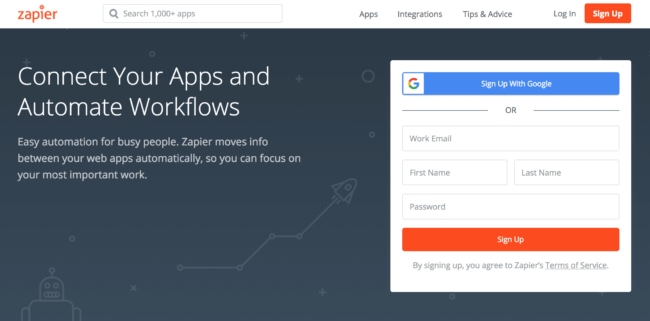
Zapier is a SaaS tool that allows you to push data from one software system or location to another easily, without writing custom code. They also allow you to do multiple step Zaps, which are logic-based ways of sending data to different systems based off different criteria.
As a SaaS tool, they are subscription-based. They have three different pricing levels, depending on your level of need, including a free level:
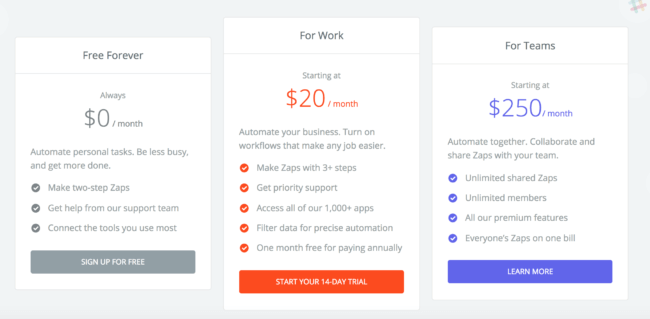
Zapier is a utility that has a natural retention play built into it – the zaps you set up continue to work and move data around like you need. Until you change technologies or quit your business, they’ll be the middleman for you and take care of the technical details of integrations so you don’t have to write custom code.
Zapier has a few levels of keywords that can drive them traffic that can convert. As a brand, they also receive a lot of branded traffic, probably on the scale of a few hundred thousand per month across their brand name (Zapier – 90k exact searches per month) and things like [slack integrations zapier].
Zapier has two other levels of keywords:
- Product name and integrations keywords
- Informational content, such as “how to integrate X and Y”
Zapier’s positioning and competition
Zapier plays in an interesting space as an integrations tool between different tools and brands. It seems possible that Zapier could rank for company names from time to time, but also that they will never be #1 simply because they do not deserve to be if the companies they are integrating are properly optimized themselves for other tools they integrate with.
Have a look at some of the “integrations” keywords Zapier ranks for (from SEMrush):


For some keywords, like [slack github integration], they’re competing against branded sites however. Zapier will likely rarely outrank these, but being #2 is great because a user who is searching for these integrations but lacks the technical ability to build the integrations themselves can then go back to the search results and find Zapier.
This is also an opportunity for Zapier to reach out to all of these companies who have built integrations that require code. Zapier can offer themselves as an alternative to writing code, and with their free level they have a very real pitch for users.
This could result in a lot of referral traffic, new users, and backlinks which will help Zapier across the board.
Competition
Zapier has a few business and search result competitors, though Zapier is the market leader. Their main competitors would be:
- IFTTT (If This Then That)
- Automate.io
- GetApp.com
When I plug these into SEMrush to compare their metrics, Zapier is heads and tails ranking for more keywords:
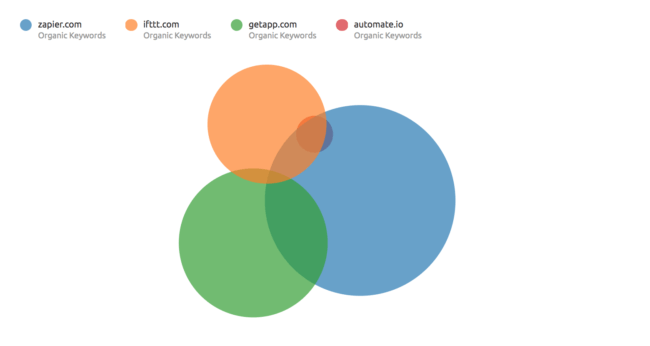
And compared to the other three with backlinks, Zapier is #2 behind IFTTT (who has been around forever) but well ahead of the other two competitors. Zapier is quite competitive with IFTTT and has a different value prop, better branding, and better monetization.

Zapier is well situated from an SEO perspective, but there is always work to be done!
Technical SEO
To do a technical audit of Zapier.com, I did a crawl with Screaming Frog to identify:
- Areas of on-page optimization opportunity;
- Areas of information architecture issues that could hurt Zapier’s rankings;
- Broken links on the site;
- Temporary redirects when permanent should be used.
On-page optimization opportunities
Zapier has the following on-page optimization issues that are opportunities to better their rankings:
- Multiple H1s present on main app integrations pages;
- Non-optimized H2s on main landing pages;
- Not much unique content about the tools they are integrating;
Multiple H1s
Zapier has multiple H1s on their main /app/ pages and /integration/ pages. There are two H1s per page when there should be just 1:
- The main title on the page;
- The final step in the breadcrumb.
I’ve never seen a breadcrumb be marked up as an H1 before. The H1 tag should be removed from here:
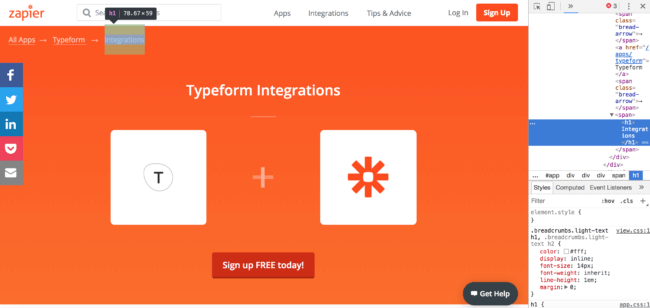
One H1 tells the search engines what your page is specifically about. Multiple H1s confuse them.
Non-optimized H2s
These same pages have H2s that do not map back to the keyword target/intent of the site.
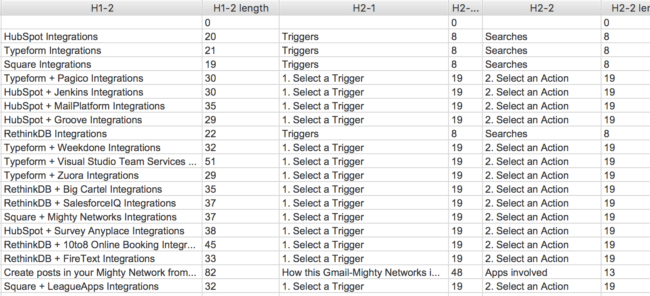
These appear here on the page:
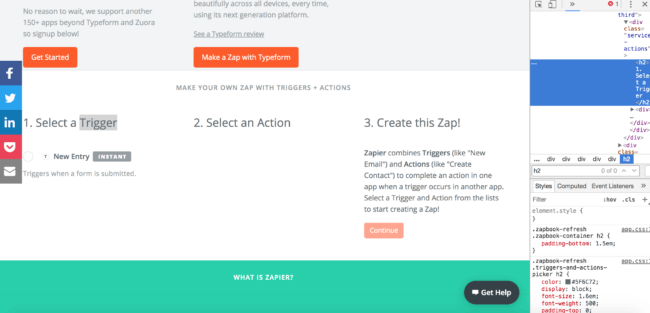
My specific recommendations for these pages would be to:
- Make these steps H3s;
- Make the “Ways to connect APP with APP” text below the main heading an H2. This is currently an H4.
This is a small change, but it helps with targeting these pages in a scalable way and can result in better rankings and therefore traffic and conversions.
Unique content
One challenge of pages like these that operate at scale (and Zapier has 295,000 of these in the index) is scaling unique and useful content. However, content about the different apps that Zapier is integrating can help these pages rank better because it’s more content and it’s relevant keyword targeted content on the page.
There are two ways Zapier could tackle this issue:
- Identify the top 50-100 integrations and pay a company like Scripted to write unique content for these pages;
- Take the content already written for the main apps pages and include that content on these pages, about both apps being integrated.
The second is a good scalable way to do this and I do not think Zapier risks “duplicate content” issues here because the page is handily enough different from a main app page that the two will not compete against each other.
Take the content from the below screenshot for each app and add it to the integration page with another app alongside the second app’s description:
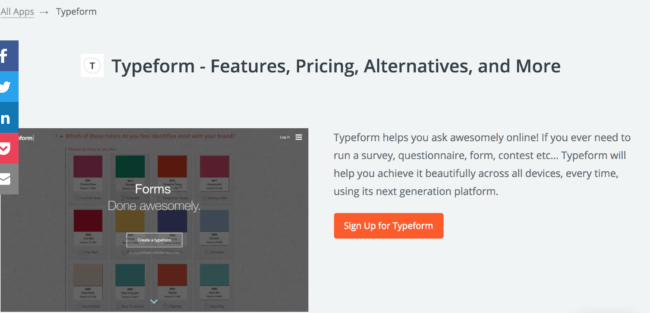
Information architecture issues
Zapier has one main information architecture issue on their site:
- No linking to categories that the tool exists within
Categories
Zapier has a concept of “Best Of” within their top navigation, which I at first thought were a category-level page but then realized are actually blog posts:
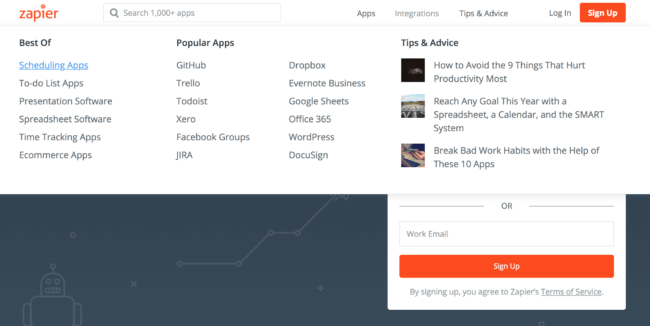
When we look in SEMrush, they are getting a fair bit of traffic here!
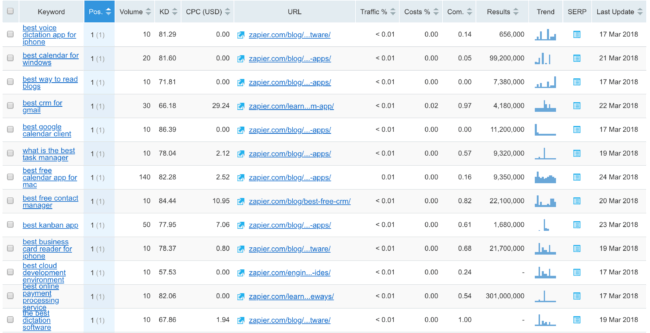
I assume that this works well for Zapier, which is why they have invested in this blog initiative.
Interestingly, they already have a categorization schema in place on their /apps/ page (on the right side):
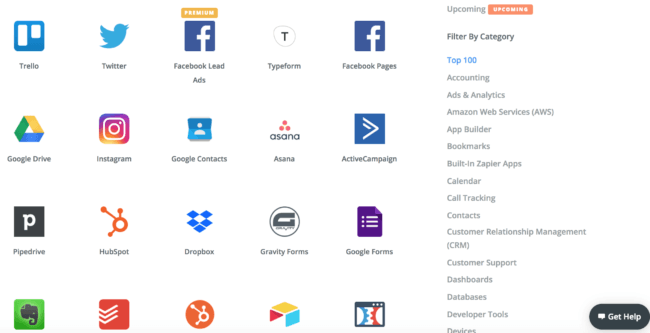
Interestingly, these pages seem to be getting no traffic:

This is because these pages have a noindex/nofollow robots meta tag applied to them. At minimum I’d remove the “nofollow” part of that. These category pages should be used for discovery of apps as well, and nofollow hurts Zapier here.
I think there is a larger opportunity here to streamline the approach to these keywords so that they’ll convert better and require less input.
I’d do the following:
- Expand the categories if needed to target the terms the blog is already targeting;
- Move the content from the blog posts to the /categories/ page;
- Remove the noindex from /categories/ pages;
- Link to these /categories/ pages instead of the /blog/ post from the top navigation;
- 301 redirect the currently ranking blog post to the /categories/ page once all of the above are done;
- Link to the category from the app pages through breadcrumb links.
If Zapier is nervous about this change, then they could test it on a few specific pages, gauge where the category page settles in for rankings, and then determine the right course of action from there.
Site errors
I crawled Zapier’s site with Screaming Frog and did not find any internal 404s, which is impressive! Zapier should look in their Google Search Console profiles to see what errors are there and then cross-reference these against backlink data to make sure that any pages 404ing do not have inbound links.
If they do discover 404ing pages with inbound links, those pages should be redirected to a relevant page somewhere else on the site.
Redirect issues
Through the Screaming Frog crawl, I discovered that Zapier is using a temporary (302) redirect from its old app pages, like https://zapier.com/apps/brightmove, to the new individual app landing page of https://zapier.com/apps/brightmove/integrations. Here is a list:

This seems to apply across the site.
Fortunately, Zapier is using the correct 301 status code for the individual integrations between two tools:
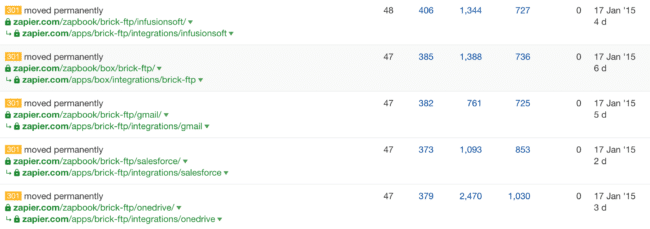
Using Moz’s new Link Explorer, I found around 100 linking root domains pointing to pages that 302 redirect:

This change alone will show results for Zapier.
Canonical logic
One interesting area to point out about Zapier’s SEO is that they have major potential for duplicate content, such as these two URLs:
- https://zapier.com/apps/slack/integrations/twitter
- https://zapier.com/apps/twitter/integrations/slack
Each combination has their own search volume:
- Slack twitter integration – 210/mo
- Twitter slack integration – 90/mo
For this specific example, Zapier ranks #4 for both with the same URL – https://zapier.com/apps/slack/integrations/twitter. This is because Zapier uses the rel-canonical tag to tell the search engines that https://zapier.com/apps/twitter/integrations/slack is a duplicate of the first.
While this makes sense with Zapier’s current integration templates, as these two pages are very near duplicates, I think that long term Zapier should figure out how to make these pages more unique from each other so both could be indexed. My prediction is that these pages could rank for their individual keywords, and higher than currently, with this approach.
This is a high effort/low to medium reward undertaking, so it’s not a high priority.
Content marketing
Zapier has invested strongly in content marketing, which is one of the things I love about Zapier and is likely a large reason for their current SEO successes.
Their blog ranks for a lot of relevant keywords:
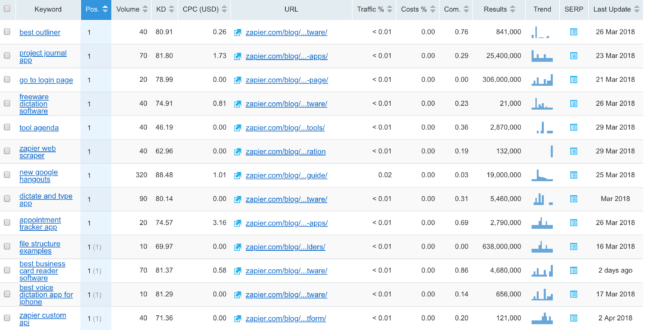
But more than that, their Learn section has 13 well produced ebooks that in my opinion elevate their brand above “blog content” and take them to the next level:
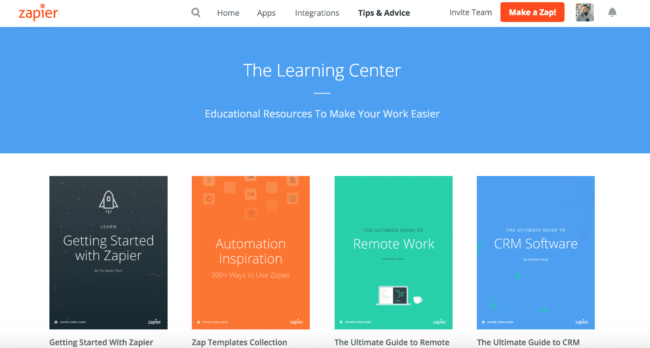
They rank incredibly well here also since all of the content is indexable and also available to download, which helps them drive qualified email subscribers who would be ideal Zapier customers:
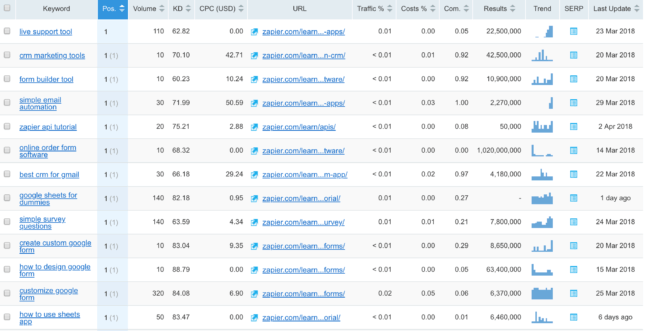
I’d be interested to see the difference between these guides and their blog content in terms of driving email subscribers and qualified (paying) signups. While free users are nice and can be converted, the real rubber meets the road when someone starts paying you.
When we look at the top pages by links on Zapier, the Learn pages have a higher ratio of published-to-links than blog posts. These take a lot more effort to produce than blog posts but in my opinion and experience are more promote-able, drive better users, and help build a brand way better than blog posts.
I’d expand this approach by taking the best performing blog posts and creating larger guides around them, as well as publishing as ebooks in epub format and promoting them on Amazon as free ebooks.
Distribution FTW.
Links
Let’s talk briefly about links for SEO. Zapier has actually done a fantastic job of getting links, being very competitive with their competitors as I already showed:

That said, there are always opportunities:
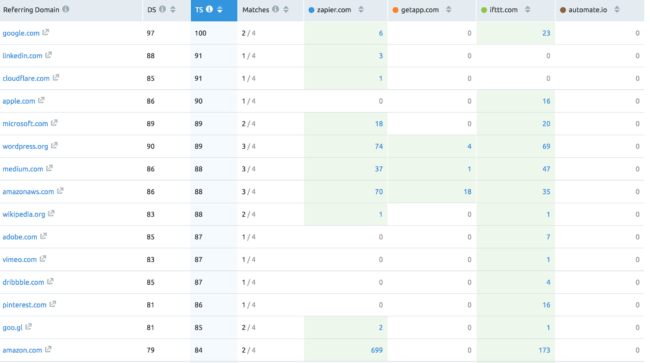
There’s always catchup to do. If I were Zapier, I’d concentrate on three main ways to build links:
- Partnerships
- Content
- Press
Partnerships
First, partnerships. Zapier’s product naturally lends itself to getting attention from the companies for which it has integrations. Sometimes Zapier has even worked directly with these companies to build out integrations, so the relationship is already built in some cases.
Zapier could launch a campaign, likely led by business development and not an SEO firm, to outreach to the companies that Zapier has listed and get itself listed on integrations and partners pages on those websites as a value-add to the company’s users.
This in and of itself could results in hundreds of strong linking root domains.
Content
When looking at link opportunities in SEMrush, something that stands out to me is websites like DailyMotion, Vimeo, YouTube, Dribbble, and GitHub that do not link back to Zapier’s site (at least as discovered by SEMrush).
This feels like a huge opportunity for Zapier to not only get links but also potentially build an audience that would use Zapier themselves. Zapier does already have a Dribbble team profile, but links there are not actual HREF links pointing back to the site so a different approach would be needed here, potentially on Dribbble’s blog about automation or marketing for designers.
GitHub is a natural place for Zapier to contribute content, as I am sure they have in the past. Zapier has nofollowed links from here because of their profile, but followed links could be gained from pages like https://github.com/zapier/zapier-platform-core by building out specific pages within the Zapier Docs section and linking to those where possible.
Finally, video content. Video content is hard and takes time, and building a following on YouTube or Vimeo is a whole new strategy and approach. But the potential to build useful how to content here is huge, YouTube videos rank very well in search results so Zapier can start to stack SERPs with their site and YouTube videos, and they can pick up a few links (mostly nofollowed) in the process.
Press
Finally, one of the bigger opportunities I see in the SEMrush backlink gap analysis is from news sites. Obviously everyone wants links from the New York Times and CNN, but these are real opportunities that IFTTT has capitalized on.
PR is a whole different strategy and level of outreach and speciality required and I do not want to sound like PR is SEO, though PR can absolutely influence SEO when done well.
Zapier has a great founding story, personable founders, and a genuinely useful product. This combination can serve Zapier well in putting together a brand narrative that is useful to journalists, as well as becoming a source when tech news breaks and Zapier has a way for users to change what they do by using the tool.
This requires a much deeper strategy that I am not qualified to go into here, but it’s an opportunity.
Conclusion
There you go Zapier, my couple hour SEO audit of your site around technical, content, and links. I hope it was useful!

